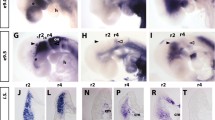Abstract.
Neural crest cells migrate along specific pathways to their destinations and, like neuronal growth cones, must be guided by extracellular cues. One example of neural crest pathfinding is the segmental migration of branchial and trunk neural crest; this is associated with the patterning of the skeletal components of the branchial arches and of the peripheral nervous system. In this review, we discuss recent work that has implicated Eph receptors and their ephrin ligands in mediating repulsive interactions that restrict neural crest cell migration. We relate these findings to the roles of these receptors and ligands in growth cone guidance and the segmental restriction of cell movement in the hindbrain.
Similar content being viewed by others
Author information
Authors and Affiliations
Additional information
Received: 2 May 1997 / Accepted: 3 June 1997
Rights and permissions
About this article
Cite this article
Robinson, V., Smith, A., Flenniken, A. et al. Roles of Eph receptors and ephrins in neural crest pathfinding. Cell Tissue Res 290, 265–274 (1997). https://doi.org/10.1007/s004410050931
Issue Date:
DOI: https://doi.org/10.1007/s004410050931




